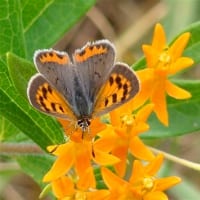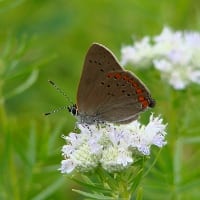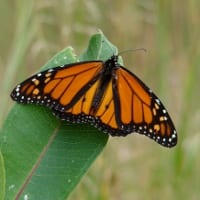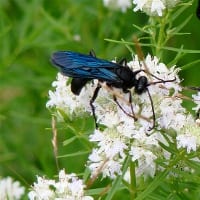by Tim Boland
This article first appeared in the Spring 2009 issue of Meristems, the newsletter of Polly Hill Arboretum.
There are many good reasons for growing native plants: Native plants are adapted to local growing conditions; they promote biodiversity and support local wildlife; and, in general, they need less maintenance. Besides, native plants are “Vineyard vernacular”: they just look right in our gardens and landscapes.
The best native plants for Vineyard landscapes are local ecotypes – plants grown from seed collected from Island plant populations, not plants brought from off-Island or grown from seed collected elsewhere. But whether gardening with native plants or using them to restore habitat, you need more than good intentions – you need plants!
In 2006 the Polly Hill Arboretum introduced a fledgling program called MV Wildtype to meet the demand for native plants in the Vineyard community. Our primary goal is the production of native plants from local wild-collected seed. Now, seven years later, our model program produces over 30 native plant species that we make available for sale to gardeners, homeowners, landscapers, and conservation groups, for landscaping with native plants, gardening, restoring habitat and maintaining biological corridors, and augmenting cultural landscapes.
Our program began with Arboretum staff collecting seed from principal Island habitats. We were fortunate to receive support from the Martha’s Vineyard Vision Fund, an organization that funds Island students committed to sustainability issues. In 2006 our Vision Fellow, Christine Brissette, worked with staff and volunteers to scout and map populations of targeted plants; later we returned to harvest seed. Seed storage, germination, and plant production would have been impossible without the opening of our greenhouse/propagation facility the same year.
While our focus was initially on charismatic natives with conspicuous blooms, like butterfly weed, in successive years we have collected less showy plants as well as grasses, sedges, and woody plants. In addition to the production of local native plants, our MV Wildtype program encourages the greater use of native plants to facilitate the connection of fragmented habitats on-Island. On a global scale, and locally—yes, right here on Martha’s Vineyard—habit fragmentation is cited as a major factor in the extinction of species.
An added benefit of recording location of seed collection sites is the spatial recording of existing plant populations. The location of each plant population we identify is recorded and placed on a digital map (using GIS mapping technologies) as part of our ConServator program, which documents the distribution of plants for the Flora of Martha’s Vineyard. It is important to note that Polly Hill Arboretum (PHA) does not collect seed from plants that are listed as endangered, threatened, or special concern by the Natural Heritage and Endangered Species Program (NHESP). However, we do collaborate with NHESP by mapping plant populations as part of their monitoring program.
A key component to the success of MV Wildtype is educating the community on the role native plants play in supporting native insects in addition to overcoming the aversion some people have to insects, caterpillars, and “bugs” in general. Native insects and native plants need each other, and we need both!
The poster child for plant-animal codependence is our native butterfly weed (Asclepias tuberosa). The dramatic orange blooms draw a bevy of insect species, none more famous than the monarch butterfly, which spends its entire life (from egg to larva to adult) reliant on this plant. The close relationship between insects and plants provides an opportunity to explain the webs of life and how critical plants are to our landscapes well beyond their ornamental qualities.
Our native plants are essential to the lifecycle of a great diversity of insects (many globally rare) that occur on Martha’s Vineyard. In 2008, we began monitoring insect populations in our fields to gain a better understanding of the codependence of our native flora and our local insect fauna.
Another objective of the MV Wildtype is increasing people’s comfort level with native plants in their home landscapes, thereby defusing the argument that it is an either/or proposition. Simply not true! If you decide to use native plants, you do not have to rule out planting exotic (non-native) plants; you can plant both and have a beautiful, dynamic, and responsible garden. Planting a subset of native plants goes a long way in maintaining the biological diversity of Martha’s Vineyard. At PHA we assure Island gardeners that their landscapes can represent their personal style while including native plants, non-native plants, and plants for food.
The Arboretum is facilitating the effort to document and promote plant diversity on the Island. While our mission includes the general sharing of knowledge of plants and scientific procedure through education, research, plant conservation, and exploration, we are taking specific actions to preserve, conserve, and improve the local environment – MV Wildtype is one example.
If you want to support Island biodiversity in your garden, you should consider joining a new initiative called the MV Habitat Network. This Nature Conservancy program educates Vineyard residents on how they can get involved promoting biodiversity in their own backyards.
Visit the program website at: http://www.nature.org/ourinitiatives/regions/northamerica/unitedstates/massachusetts/explore/vineyard-habitat-network.xml.
About the Author
Tim Boland is the Executive Director of the Polly Hill Arboretum located in West Tisbury, MA. He may be reached at Tim@pollyhillarboretum.org.





